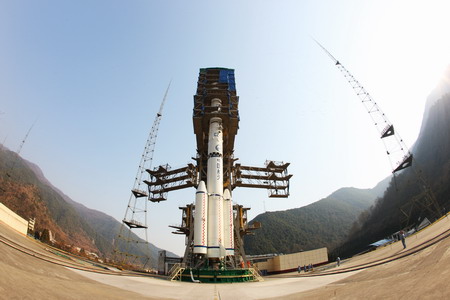Government and Policy
China launches orbiter for navigation system
(Xinhua)
Updated: 2010-01-17 18:06
 |
Large Medium Small |
|
 The Long-March-3III carrier rocket sits atop launch pad at Xichang Satellite Launch Center Jan 16, 2010.
[Photo/Xinhua]
|
The original Beidou system provide regional service for telecom, transport and disaster relief within the country, and has played important roles especially in the Beijing Olympics and relief work for the 8.0-magnitude Wenchuan earthquake in May 2008.
A statement from the COMPASS system's special management office said that China will make its own global navigation system compatible and interoperable with other international competitors, including the US GPS system, the EU's Galileo Positioning System and Russia's Global Navigation Satellite System (GLONASS).
The compatibility and interoperability, under the framework of the International Committee on Global Navigation Satellite Systems (ICG) and International Telecommunication Union (ITU), will make all users benefit from the progress of the satellite navigation's development, it said.
China is willing to cooperate with other countries to improve the COMPASS system's compatibility and interoperability with other satellite navigation systems and promote an all-round application of the system's services, the statement said.
Sun Jiadong, an academician with the Chinese Academy of Sciences and the COMPASS system's chief designer, told Xinhua after the third orbiter's launch that the system would play a major role in providing services for national security, environment, traffic, logistics and other economic activities.
"There is nothing could not be accomplished by the COMPASS system," said the 80-year-old Sun at the launch center, who was crowned China's top science and technology award by President Hu Jintao last week.
The Beidou experimental system with two satellites in geostationary orbit completed in 2000 was the first successful stage which helped Chinese scientists gain lots of experience in constructing the COMPASS system, Sun said.
According to him, the blueprint to build China's own global navigation satellite system in three stages was initiated in the 1980s and 1990s.
"The successful launch of the COMPASS system's third orbiter today marked a substantial step for the system to function within the Asia Pacific region by 2012 as the second stage," he said.
With promising application in social and economic activities, the COMPASS system will also boost the development of China's information technology, the chief designer said.
"In a few years, people would find some new application of the COMPASS system that they have never imagined before."
With the steady progress to add launch satellites into space, the development of ground-based supporting facilities and equipment to explore the system's application is comparatively limited and should be considered as priority, the space expert said.
Civilian application of the US GPS system in China is limited. Only a few companies sell GPS maps for portable or vehicle-mounted positioning and navigation devices.
Sun proposed that the government should issue regulations and policies to encourage more Chinese enterprises to participate in the development of the system's application chain so as to make maximum possible use of those satellites.













